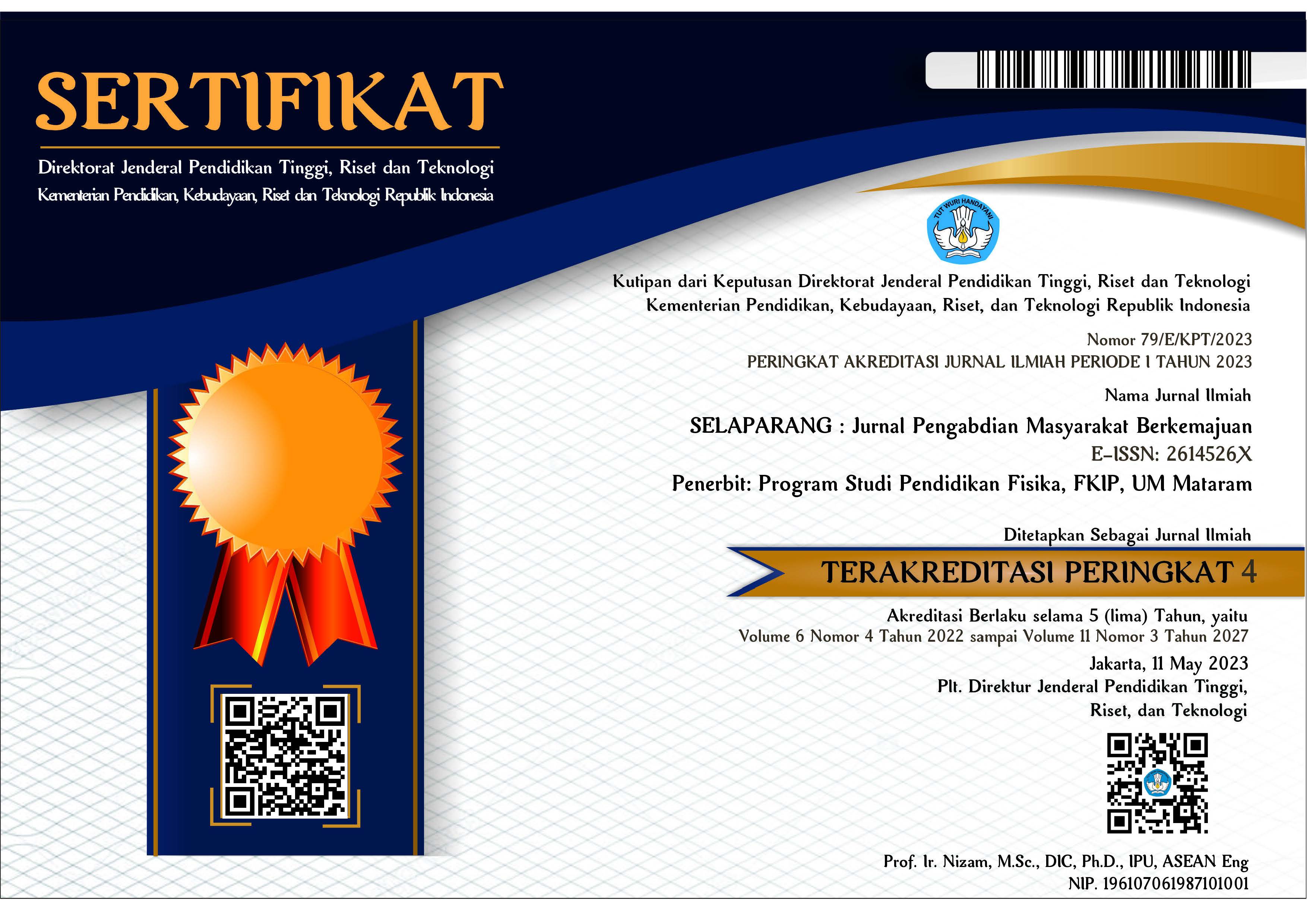Pendampingan dan evaluasi penggunaan kaki prosthetic bagi amputee diabetes di atas lutut (Prosthetic Foot Transfemoral)
Abstract
Abstrak
Prosthetic foot merupakan alat bantu rehabilitasi medis yang dirancang untuk dapat menggantikan fungsi kaki bagi tuna daksa yang dapat disebabkan beberapa faktor yaitu kecelakaan, amputasi dan kondisi medis lainnya. Diabetes melitus salah satu penyebab terjadinya amputasi atas lutut yang menyebabkan kehilangan fungsi kaki dalam melakukan mobilitas sehari-hari. Pada pengabdian ini akan berfokus pendampingan dan mengevaluasi penggunaan kaki prosthetic foot transfemoral bagi tuna daksa bagian kaki amputasi atas lutut. Pada kasus amputasi di atas lutut yang menggunakan prosthetic foot transfemoral yang memiliki struktur yang lebih kompleks dan membutuhkan waktu yang lama untuk beradaptasi yang memerlukan pendampingan dari pre pemasangan dan saat pengguna menggunakan prosthetic foot transfemoral. Kegiatan pengabdian dalam proses pendampingan pengguna prosthetic foot transfemoral dan mengevaluasi apa saja kendala yang dihadapi dalam proses berjalan untuk mengembalikan siklus gait pengguna. Metode yang di gunakan pada kegiatan ini meliputi tahapan rencana kegiatan dan strategi, produksi prosthetic hoot, hibah prosthetic foot dan pengevaluasian prosthetic foot. Mitra kerjasama pada kegiatan ini adalah satu pengguna dari Himpunan Wanita Disabilitas Indonesia (HWDI) dan mitra kerjasama pembuatan prodthetic foot tranfemoral yaitu Klinik Orthotic Prosthetic Promedik Semarang. Kegiatan pendamingan berjalan 5 bulan dengan 7 pertemuan yang fokus pada evaluasi penggunaan dan adaptasi terhadap prosthetic foot tranfemoral. Hasil kegiatan pendampingan ini meunjukan peningkatan yang signifikan dari kemandirian penguna dalam berjalan dan melakukan aktivitas, terdapat beberapa kendala yang dialami akan tetapi dapat diselesaikan melalui penyesuaian produk dan pelatihan lebih intesif.
Kata kunci: tuna daksa; prostetik foot transfemoral
Abstract
A prosthetic foot is a medical rehabilitation aid designed to replace the function of the foot for people with disabilities, which can be caused by several factors, namely accidents, amputations, and other medical conditions. Diabetes mellitus is one of the causes of amputation of the knee which causes loss of leg function in carrying out daily mobility. This service will focus on assisting and evaluating the use of transfemoral prosthetic foot for physically disabled above-knee amputees and in the case of amputation above the knee using a transfemoral prosthetic foot which has a more complex structure and requires a long time to adapt which requires assistance from pre-installation and when the user uses a transfemoral prosthetic foot. Service activities in the process of assisting transfemoral prosthetic foot users and evaluating what obstacles are faced in the walking process to restore the user's gait cycle. The methods used in this activity include the stages of activity planning and strategy, production of prosthetic hoot, granting prosthetic foot, and evaluating prosthetic foot. The cooperation partner in this activity is one user from the Indonesian Disabled Women's Association (HWDI). The cooperation partner for making tranfemoral prosthetic foot is the Promedik Semarang Orthotic Prosthetic Clinic. The mentoring activity lasted 5 months with 7 meetings that focused on evaluating the use and adaptation of the prosthetic foot.
Keywords: quadriplegics; transfemoral foot prosthetics.
Keywords
Full Text:
PDFReferences
Annur, F., Sjafari, A., & Riswanda, D. (2023). Penghormatan Hak-Hak Penyandang Disabilitas Melalui Kebijakan Kuota Kerja di Indonesia. In JIAP (Vol. 9, Issue 3).
Hamza, M. F., Ghazilla, R. A. R., Muhammad, B. B., & Yap, H. J. (2020). Balance and stability issues in lower extremity exoskeletons: A systematic review. In Biocybernetics and Biomedical Engineering (Vol. 40, Issue 4, pp. 1666–1679). Elsevier Sp. z o.o. https://doi.org/10.1016/j.bbe.2020.09.004
Ichimura, D., Hisano, G., Murata, H., Kobayashi, T., & Hobara, H. (2022). Centre of pressure during walking after unilateral transfemoral amputation. Scientific Reports, Vol 12(1). https://doi.org/10.1038/s41598-022-22254-5
Li, B., Xiang, Q., & Zhang, X. (2020). The center of pressure progression characterizes the dynamic function of high-arched feet during walking. Journal of Leather Science and Engineering, Vol 2(1). https://doi.org/10.1186/s42825-019-0016-6
Made Dyah Ayu, N., & Rahmawati, I. (2022). FAKTOR-FAKTOR YANG MEMPENGARUHI TERJADINYA ULKUS KAKI DIABETIK PADA PASIEN DIABETES MELLITUS TIPE 2. Vol 11(No 2), 2598–4217.
Mannan Balaramakrishnan, T., Natarajan, S., & Srinivasan, S. (2020). Roll-over shape of a prosthetic foot: a finite element evaluation and experimental validation. olume 58, 2259–2270. https://doi.org/10.1007/s11517-020-02214-9/Published
Pecoraro, R. E., Reiber, G. E., & Burgess, E. M. (1990). Pathways to Diabetic Limb Amputation Basis for Prevention. In DIABETES CARE (Vol. 13, Issue 5). http://diabetesjournals.org/care/article-pdf/13/5/513/439750/13-5-513.pdf
Ramadhan Fitrianto dan Rini Dharmastiti, T. (2019). EVALUASI PRODUK KAKI PROSTETIK BAWAH LUTUT BERDASARKAN PERSEPSI PENGGUNA USIA 15-64 TAHUN. Vol 1(1).
UNDANG-UNDANG REPUBLIK INDONESIA NOMOR 8 TAHUN 2016 TENTANG PENYANDANG DISABILITAS. (2016). https://bphn.go.id/data/documents/16uu008.pdf
World Health Organization. (2017). Part 1: STANDARDS Technical contribution: STANDARDS FOR PROSTHETICS AND ORTHOTICS • PART 1. STANDARDS WHO standards for prosthetics and orthotics Contents: Part 1. Standards; Part 2. Implementation manual. http://apps.who.int/bookorders.
DOI: https://doi.org/10.31764/jpmb.v8i4.26949
Refbacks
- There are currently no refbacks.

This work is licensed under a Creative Commons Attribution-ShareAlike 4.0 International License.
______________________________________________________
Jurnal Selaparang
p-ISSN 2614-5251 || e-ISSN 2614-526X
EDITORIAL OFFICE:



















